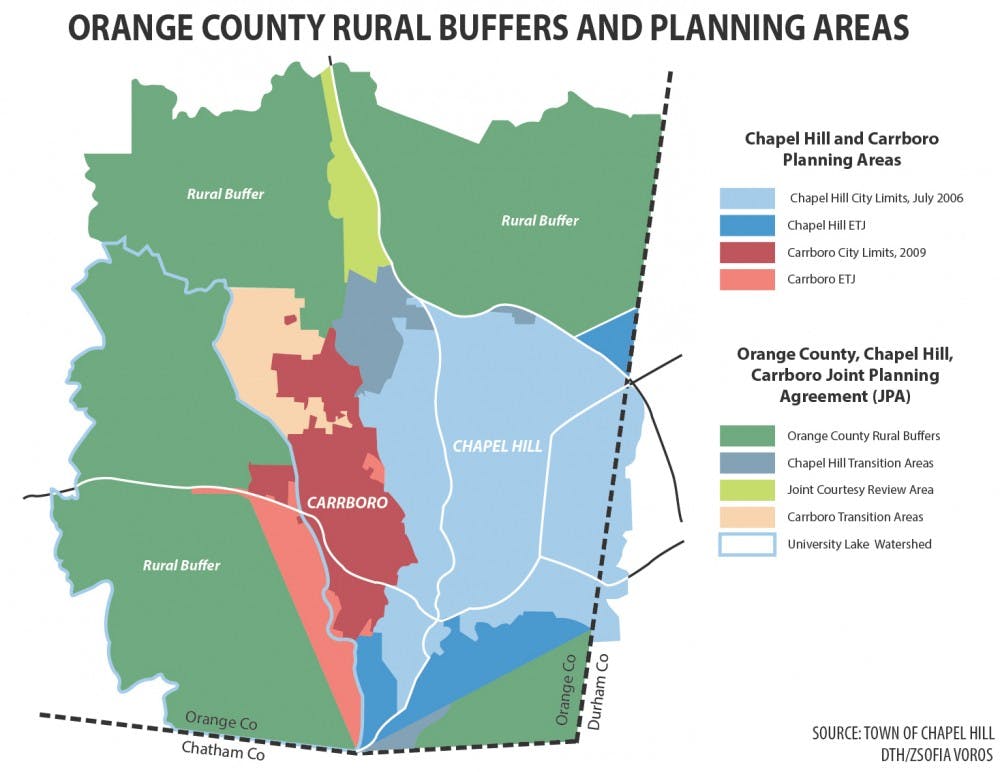"The rural land buffer was drawn on my kitchen table about 30 years ago — my son had some pencils and crayons and was helping me," Waldon said. "I had information about the topography, build patterns and tracing paper, and basically, I tried to put all these ideas together to come up with this urban growth boundary."
Today, Waldon said the buffer has largely succeeded. Chapel Hill and Carrboro are water-independent, public services are not spread too thin by sprawl and transportation is manageable.
Orange County Board Commissioner Barry Jacobs agreed the rural land buffer has allowed Orange County to preserve and grow its agricultural economy rather than watch its farmland be consumed by sprawl.
Jacobs said a presentation is planned in the spring for the 30th anniversary of the buffer’s creation to remind elected officials and the public of its importance, size and affect on water and air quality.
“There are occasionally questions, proposals that don’t really understand how it works,” he said. “We just need to have a proactive way of discussing them without it being a ‘you can’t talk about this’ kind of thing.”
The original agreement had over 1,000 acres of "transition area" for Chapel Hill and Carrboro as a way to have some land to develop on that has access to town services like sewage and garbage collection, Jacobs said.
Orange County Board Commissioner Mark Marcoplos said the buffer has served the county well on the whole, though he could support some small changes to benefit the public at large.
“Basically, you have developers who look out there and see that as the new frontier,” Marcoplos said. “Lots of times they’ll lead by saying that there’s nothing that they care more about than affordable housing, and of course they’d like to go out there and put in a few affordable housing units as part of the much larger development.”
Desiree Goldman, a real estate broker at Re/Max Winning Edge, said she believed it was time for some change for the buffer after 30 years.
Goldman said she agrees parts of the rural buffer that preserve the water shed should be protected from development, but believes the area along Interstate-40 is a prime area to expand the commercial tax base, easing the emphasis placed on property taxes.
“This is where people who travel, we want them to stop, have dinner in our county, stay in a hotel in our county, shop at a store in our county, so we get tax dollars,” she said. “Plus, these are jobs that people in our county can work at that are having to commute to the triangle.”
Goldman, who has been a realtor in Chapel Hill since 1998, said the buffer has factored in driving up housing prices by restricting the amount of land available for development. This has particularly impacted young, first-time home buyers who may not be able to afford the higher home prices.
To get the day's news and headlines in your inbox each morning, sign up for our email newsletters.
While she supports subsidized affordable housing, which relies on funding to keep homes within people’s price ranges, Goldman said market-rate affordable housing is the best way to attract first-time home buyers.
Marcoplos disagreed and said providing affordable housing is independent from the rural land buffer because the town still has plenty of land available.
“There’s land that the county, Chapel Hill and Carrboro jointly own, called the Greene Tract, which has lots of room for affordable housing on it just south of the rural buffer,” Marcoplos said.
Goldman said the land buffer doesn't hurt her real estate business but she has observed change over the years.
“I have seen less young families move to Chapel Hill, Carrboro in particular because they can’t afford it,” she said. “I’ve been in the business 20 years, and 10 to 20 years ago, I had more younger families than I see now."
city@dailytarheel.com



